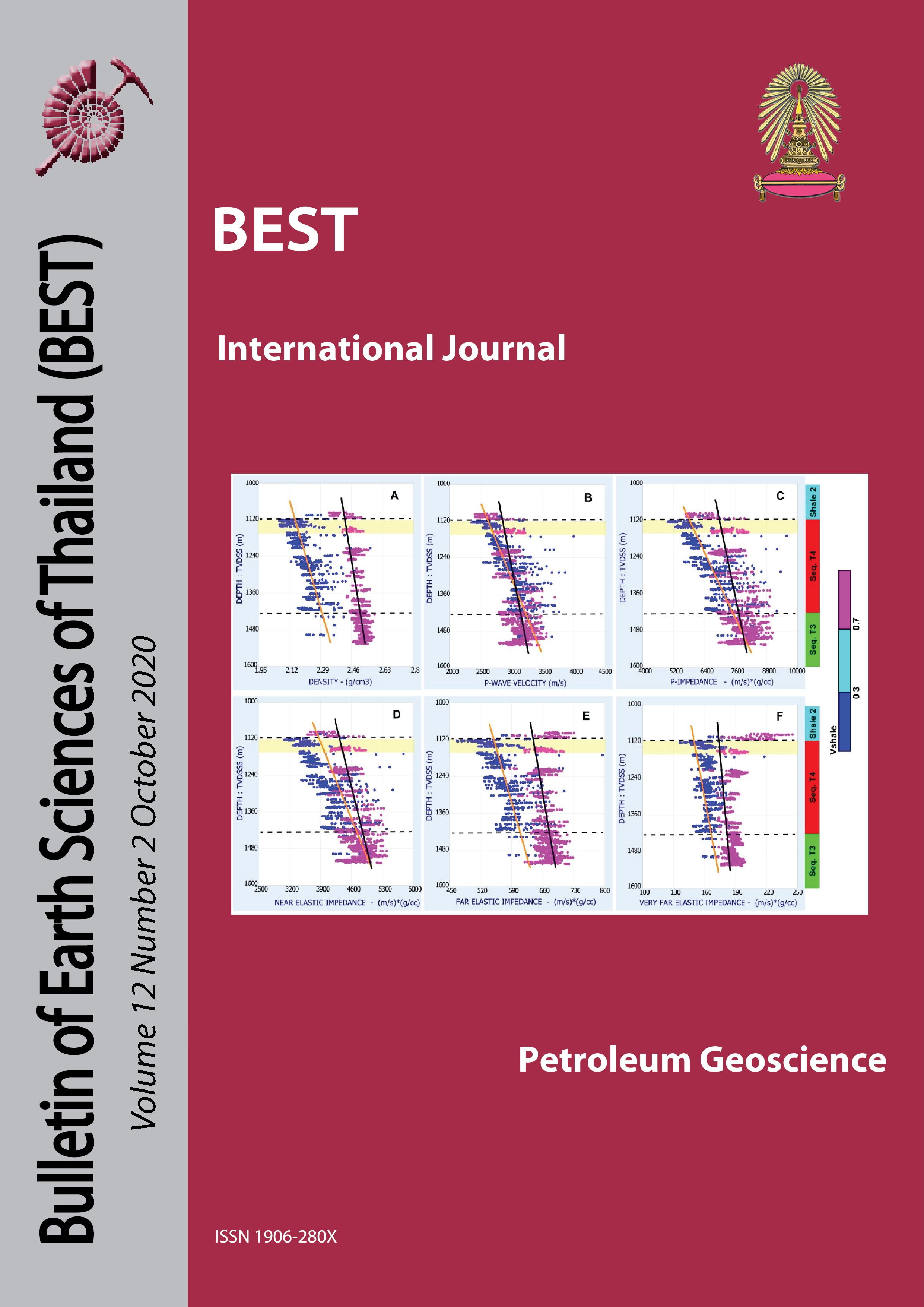High-Resolution Mapping of Plio-Pleistocene Reservoir Depositional Facies in Zawtika Gas Field, Gulf of Moattama, Using Stratal-Slicing Techniques and Attribute Analysis
Main Article Content
Abstract
Zawtika gas field (M9 block) is currently producing mainly biogenic gas from structural closure of multi-stacked deltaic sandstone reservoirs in the Pliocene-Pleistocene sequences. Mapping the sandstone reservoirs based on seismic amplitude anomaly is one of the key success in this area. However, reservoir maps are only relied on simple interpretation of a couple of easily-interpreted horizons. Thin reservoir-related features between the interpreted horizons can be missed out. In order to capture all geological features within this interval, fifty-two stratal-slicing surfaces were generated and analyzed using PaleoScanTM software. Stratal-slicing is a technique that extracts iso-age surfaces within an interval from seismic volume for detection of reservoir features at a fine scale. The ultimate aim of this study is to understand 1) facies of depositional environment and 2) distribution of hydrocarbon presence and remaining prospects in study area.Three attribute volumes (RMS amplitude, sweetness, and variance) were applied to the stratal-slicing surfaces. The results show that most of the study area aligns in coastal environment, which consists of prograding features, canyon features and tributary channelized features. Delta slope and pro-delta is limited to the west and south of the area. The main reservoirs in study area can be confirmed as tidally influenced deltaic environment. From attributes study, vast amounts of strong amplitude anomaly and structural delineation can be observed clearer and more obvious in shallow part than deeper part. Most of high attributes values are related to gas sand, obviously in shallow part and related with structural trap, whereas, there are some gas bearing sands are not related to amplitude anomaly such in middle and deeper parts. From the study, the hiding seismic anomaly in sub-horizons that generated from horizons stack attributes can reveal potential and give confidence to define the drilling area in the future and can be taken forward to in-place volume with associated risking and ranking required for final prospect assessment. hence significantly contributing to investigate the upside potential in the study area for future assessment.
Article Details

This work is licensed under a Creative Commons Attribution-NonCommercial-NoDerivatives 4.0 International License.
Copyright © 2008 Department of Geology, Faculty of Science, Chulalongkorn University. Parts of an article can be photocopied or reproduced without prior written permission from the author(s), but due acknowledgments should be stated or cited accordingly.
References
Morley, C. K. 2017. Cenozoic rifting, passive margin development and strike-slip faulting in the Andaman Sea: a discussion of established v. new tectonic models, Geological Society, London, Memoirs 47(1): 27-50.
Roger M. SLATT, 2006. Stratigraphic reservoir characterization for petroleum geologists, geophysicist, and engineer, 311-336.
Octavian C., 2006, Principles of sequence stratigraphy, Textbook, Department of Eart and Atmospheric Sciences, University of Alberta, Canada, 10-14.
Dong X., Sun Z., 2018. Main Factors Analysis of Deep Water Biogenic Gas Accumulation, AAPG/EAGE/MGS Myanmar Oil and Gas Conference, Myanmar.
Lynn M., 2019. Biogenic Gas Potential of Myanmar; The 4th AAPG/EAGE/MGS Myanmar Oil and Gas Conference, Myanmar.
P. A. Alao, S. O. Olabode, and S. A. Opeloye, 2013. Integration of Seismic and Petrophysics to Characterize Reservoirs in ‘‘ALA’’ Oil Field, Niger Delta, Hindawi Publishing Corporation, The Scientific World Journal, 3.
Eliis, 2019, PaleoScanTM 2019 User Guide.
Schlumberger, 2019, Petrel E&P Software Platform. [Online]. Available from: www.software.slb.com.
Isis Petroleum Consultants, 2007, Sequence Stratigraphy and Burial History Modelling Review of Blocks M3, M6, M9 and M11.
PTTEP, 2018, Petroleum System Synthesis of M9 West.
PTTEP, 2020, Gulf of Moattama Regional Petroleum Geology.
PTTEP, 2015, Zawtika Core Area Stratigraphic Framework and Nomenclature.
PTTEP, 2017, New Resource Assessment in M9 Main Zawtika Area (Block M9, Offshore Myanmar).
Morley C.K., 2010, Structural and tectonic setting of Myanmar offshore blocks, M3, M4, M7 & M9.
Morley C.K., 2007, Structural study of block M9, offshore Myanmar.
Schlumberger, GmbH (Koronful N. Masurek N.), 2017, Biogenic Gas Generation Study Phase II.


